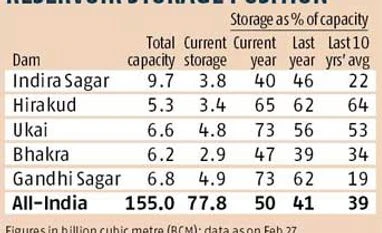The Central Water Commission (CWC) estimates 85 key reservoirs of the country hold 77.8 billion cubic metres of water, around 50 per cent of capacity. This compares well against the 41 per cent storage at the same time last year and an average 39 per cent in the last 10 years.
"Summer deficits are not going to be as severe this year as before. Apart from the slowdown in demand, a lot of states' discoms have contracted significant power in advance," said Debasish Mishra, senior director at Deloitte. While demand has been flat this fiscal, power generation has jumped 6 per cent on the back of 10 per cent growth in capacity addition.
India's largest dam, Indira Sagar in Madhya Pradesh with a capacity of 9.7 billion cubic metres, is running on 40 per cent storage as against the last 10 years' average of 22 per cent. Among the other large dams, Hirakud in Odisha has 65 per cent storage against last year's 62 per cent; Ukai in Gujarat has 73 per cent against last year's 56 per cent; and Gandhi Sagar in Madhya Pradesh has 73 per cent against 62 per cent last year.
The prospects are particularly bright for the northern region with its largest dam, Bhakra in Himachal Pradesh with a capacity of 6.2 billion cubic metres, storing 47 per cent against the last ten years' average of 34 per cent. The second largest dam in India meets the power and irrigation needs of Himachal Pradesh, Punjab, Haryana, Rajasthan and Gujarat.
Overall, water storage is better than last year in Himachal Pradesh, Rajasthan, Odisha, West Bengal, Gujarat, Maharashtra, Uttar Pradesh, Uttarakhand, Madhya Pradesh, Andhra Pradesh, Karnataka, Kerala and Tamil Nadu. Only two states, Jharkhand and Punjab, have relatively less storage this year. India Meteorological Department (IMD) data show the post-monsoon rainfall in October 2013 - which was 61 per cent above normal against 27 per cent below normal in the same month in 2012 - is a key reason for the improved storage.
Some of the large-sized plants with better coal stocks include the 1,360 Mw Panipat power station in Haryana, the 1,278 Mw Obra plant in Uttar Pradesh, the 500 Mw plant in Bhilai in Chhattisgarh, the 870 Mw Gandhinagar power plant in Gujarat and the 4,260 Mw Vindhyachal project in Madhya Pradesh. Coal-fired plants account for around 70 per cent of the total 936 billion units of electricity generated in India annually. The 100 coal-based stations consume around 360 million tonnes of coal a year. Coal India's output, after remaining stagnant for two years, grew 3 per cent to 409 million tonnes between April 2013 and February 2014. Data from the spot power market suggest that Indian states are increasing power purchases as general elections draw near. The volume of buy bids at India's largest power exchange, India Energy Exchange (IEX), has grown consistently from 2,578 million units in June 2013 to 2,899 million units in August, 3,596 million units in October and 3,848 million units in January. Haryana bought 162 million units of power in January against 47 million units in the same month last year, Maharashtra bought 218 million units against 12 million units, Gujarat bought 717 million units against 500 million units, West Bengal bought 224 million units against 51 million units year and Chhattisgarh purchased 26 million units against 8 million units.
The states are being helped in their pre-election purchases by subdued power prices in the spot market. Power exchanges registered an average price of Rs 2.9 per unit in the quarter ended December and Rs 2.8 per unit in the 10 months ended January, the lowest in five years. The slump in prices is due to a near stagnation in power demand that has grown by less than 1 per cent in the current fiscal year.
)